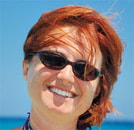While vacationing on a small island near Puerto Rico, I found a funny sign on a fruit stand. It read, "Opened some days, closed others." The ancient Roman cemetery of Portus management shares this philosophy, as it is only open four days a week and only upon request. Let me tell you. I don't always share this laid-back, Roman attitude. Lately, it's been getting on my nerves. But, after suffering the sweltering, high-season Vatican crowds, this place looked like Eden.
I quickly booked our reservation by mail the day before the visit, and on a sunny day in November, a friend and I arrived at this peaceful oasis, a mere 6-minute drive from the International Airport Leonardo da Vinci. The guard and his two dogs welcomed us warmly, and we could wander the ruins of this ancient cemetery for hours, escorted only by one of the pups. No one else was there. Nobody stopped us from entering every single tomb. In complete solitude, we marveled at the beauty of the decorations and the stories they told of the lives of those buried there.
I quickly booked our reservation by mail the day before the visit, and on a sunny day in November, a friend and I arrived at this peaceful oasis, a mere 6-minute drive from the International Airport Leonardo da Vinci. The guard and his two dogs welcomed us warmly, and we could wander the ruins of this ancient cemetery for hours, escorted only by one of the pups. No one else was there. Nobody stopped us from entering every single tomb. In complete solitude, we marveled at the beauty of the decorations and the stories they told of the lives of those buried there.
This necropolis (city of the dead) was built in the first century A.D., following the growth of the city of Portus, the new port built by Emperor Claudius and developed by Emperor Trajan. This port, a hexagonal basin, was built by Trajan to protect the ships from storms and the harbor from the encroaching sands of the river Tiber.
The Necropolis of Portus was discovered in 1925, and about 150 tombs were dredged from the silt since the fall of the Roman Empire.
Most of the tombs are red brick family tombs. The ones most capturing my imagination tell the stories of their inhabitants. In one, an elegant stucco shows the deceased’s passion for wine, depicting him riding his horse in reverse in his inebriated state. In another, a midwife is pictured helping a woman in childbirth while a doctor dresses another patient’s leg. Some other tombs depict the trade of the deceased, one an artisan, another a miller. Many have intricate mosaics and a welcome stone mat for visitors at their entrances. Some more exotic decorations, crocodiles and hippopotamus, are reminders of the deceased’s travels and trade with the African provinces.
The Necropolis of Portus was discovered in 1925, and about 150 tombs were dredged from the silt since the fall of the Roman Empire.
Most of the tombs are red brick family tombs. The ones most capturing my imagination tell the stories of their inhabitants. In one, an elegant stucco shows the deceased’s passion for wine, depicting him riding his horse in reverse in his inebriated state. In another, a midwife is pictured helping a woman in childbirth while a doctor dresses another patient’s leg. Some other tombs depict the trade of the deceased, one an artisan, another a miller. Many have intricate mosaics and a welcome stone mat for visitors at their entrances. Some more exotic decorations, crocodiles and hippopotamus, are reminders of the deceased’s travels and trade with the African provinces.
| Useful tips: You need a car to reach Rome city center in about 40 minutes. Otherwise, if you have some hours before your connecting flight, you can take a taxi from the arrival of Leonardo da Vinci International Airport of Rome. From the Airport it is only 6 minutes by car. You can have a seaside lunch in the town of Fiumicino. You can also visit the port's nature park and the docks' ruins. Nearby is also the ancient Port of Rome, Ostia Antica, one of my favorite places in Rome. If you need any further information, contact me at [email protected] |


